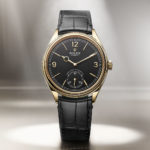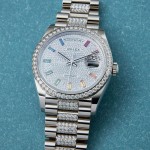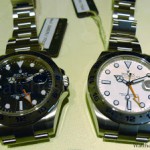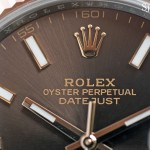Hands On: Rolex Perpetual 1908 Refs. 52508 and 52509
A dress watch done the Rolex way.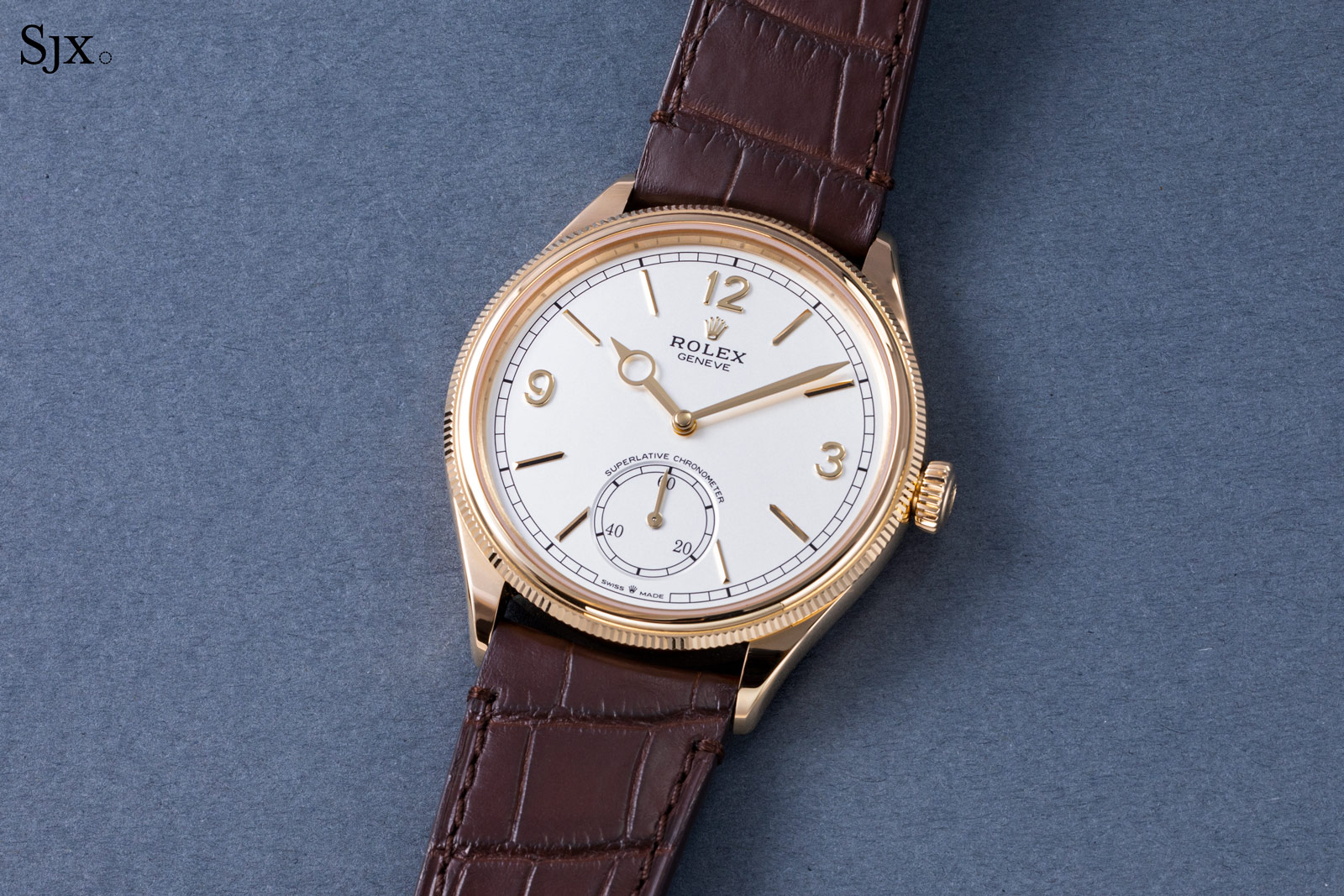
One of the most compelling new releases at Watches & Wonders (W&W) was the Rolex Perpetual 1908, brand’s most serious take on the dress watch in decades. Elegantly sized and surprisingly thin, the 1908 is equipped with the all-new, automatic cal. 7140.
Perhaps the most significant debut from Rolex in recent years, the 1908 replaces the ill-fated Cellini. Named after the year Rolex was founded by Hans Wilsdorf, the 1908 is significant not so much for what it is – a dress watch with exceptional quality of manufacture – but simply because it is the first new collection of watches from Rolex in decades.
Importantly, the 1908 is the first model in the new Perpetual collection, which implies that Rolex will be introducing more watches like this in time to come.
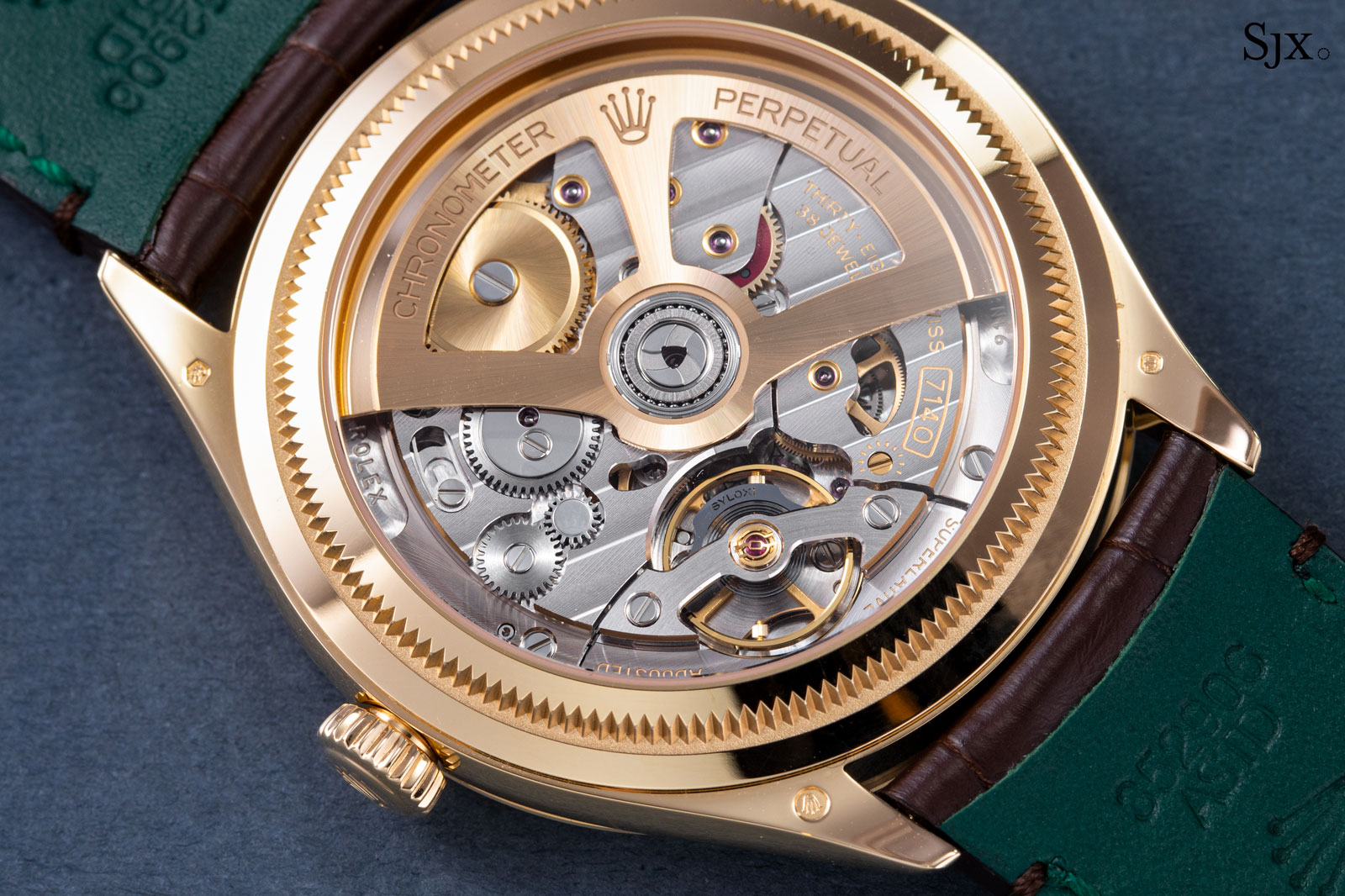
Initial thoughts
In my view, the Cellini collection always felt underdeveloped. The models introduced in 2017 had potential, but they shared too much in common with their sportier siblings, both in terms of movements and dimensions, leaving them feeling too clunky to be an alternative to the entry-level dress watches from traditional haute horlogerie brands.
The 1908, on the other hand, feels like a proper effort. Compared to the outgoing Cellini models, almost every detail has been tangibly upgraded to some degree. In the hand, the 1908 feels like a Rolex – the tactile feel of quality is quickly apparent. Despite being fairly svelte at 9.5 mm high, the case of the 1908 has the solidity of an Oyster case – the case is extremely impressive for a dress watch.
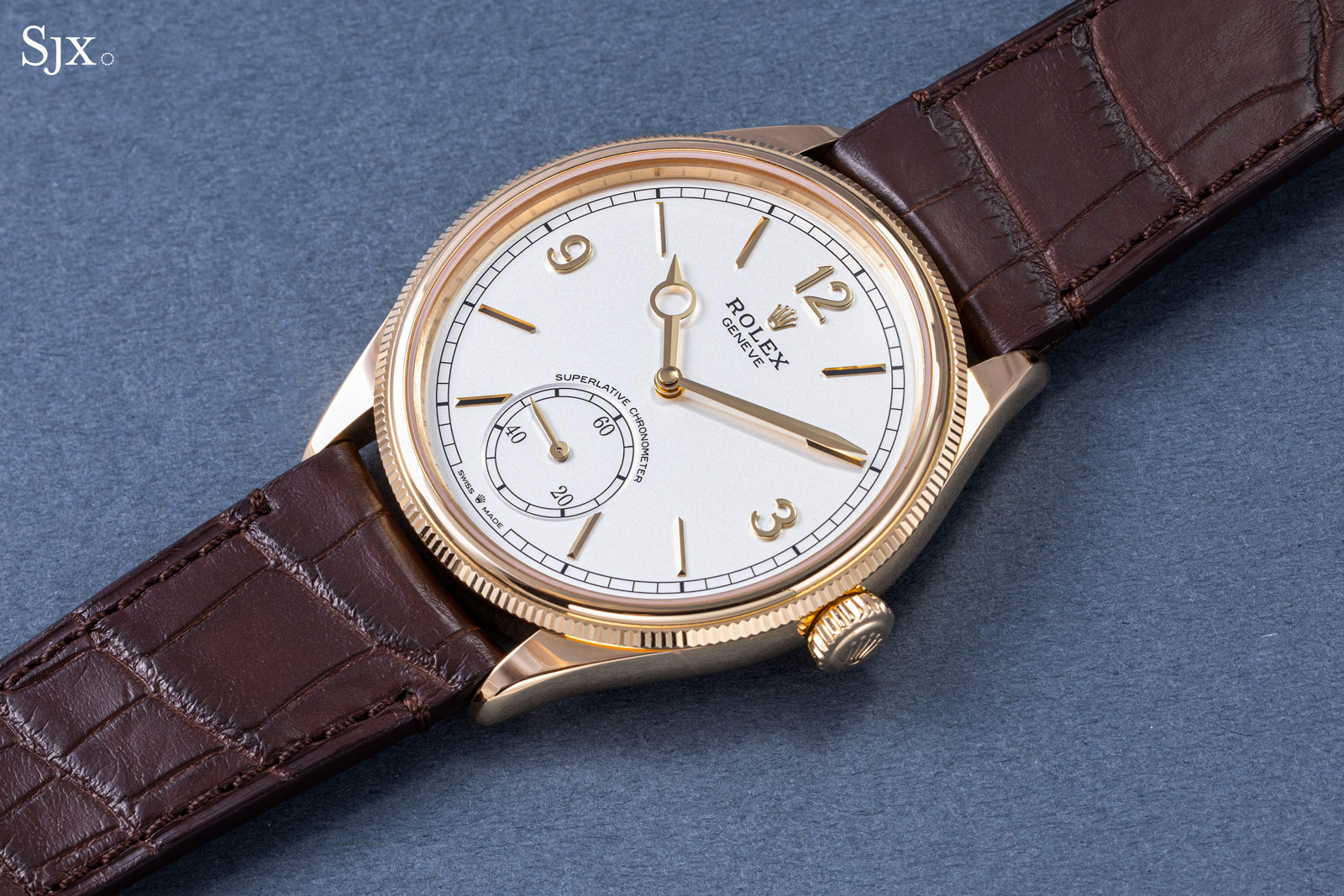
That said, the dial design does feel like an initial attempt. The designers at Rolex probably haven’t had that much experience with classical dress watch styling and it comes through in the dial. The design is mostly attractive, but some of the elements don’t quite complement each other.
Available in yellow or white gold with white or black dials, the Perpetual 1908 is conservative (at least for now). All four versions are appealing, but in my view the watch really comes alive in yellow gold, a metal that suits the retro design best.
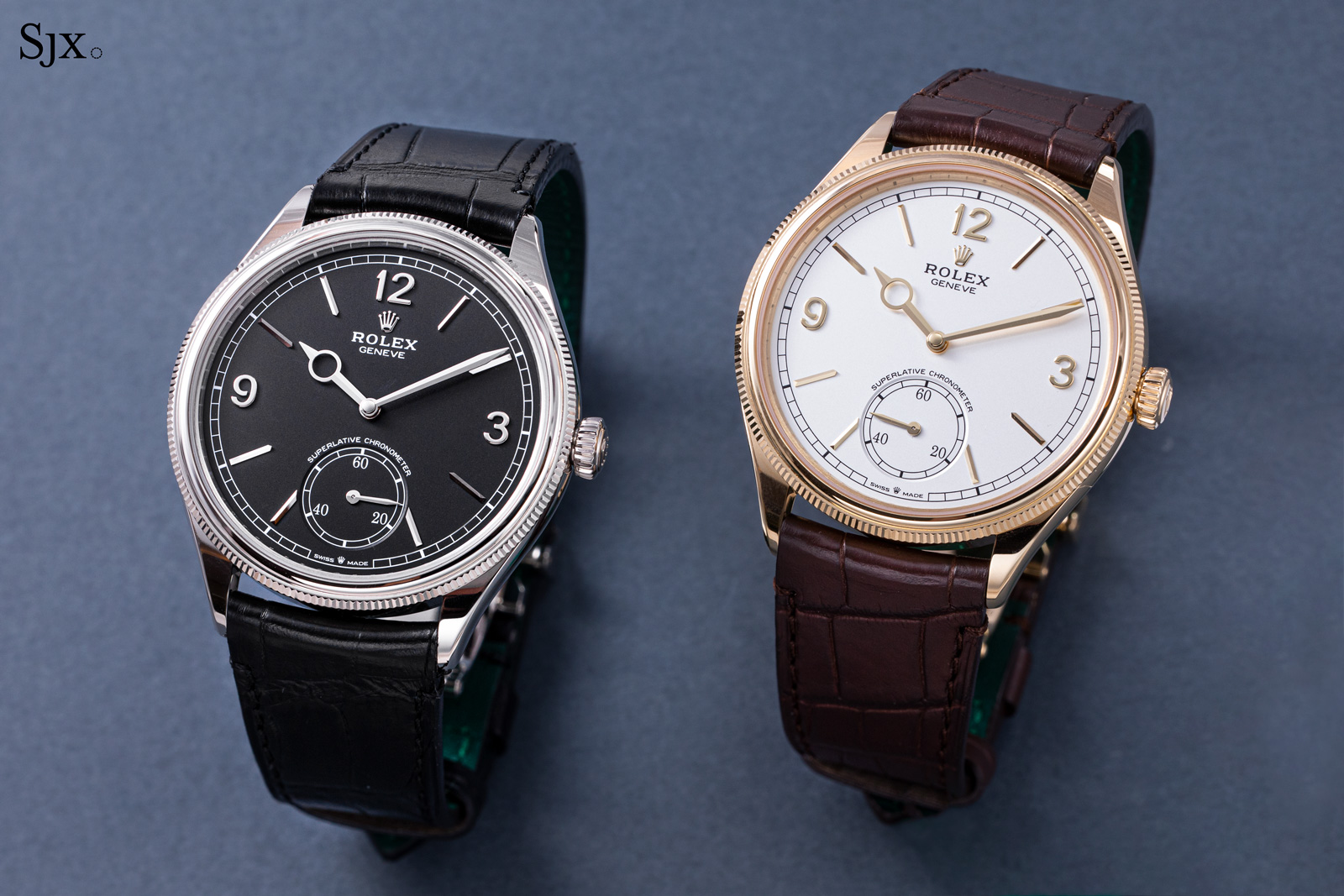
At US$22,000 in yellow gold and US$23,300 in white gold, the Perpetual 1908 is actually a lot of watch for the money, both intrinsically and extrinsically. It represents a good value considering the competitive landscape. The 1908 costs about 13% more than a Jaeger-LeCoultre Master Ultra Thin in pink gold, and about the same price as a Vacheron Constantin FiftySix in the same metal. Given the stronger brand, near parity in finishing, and technical superiority of the case and movement, the 1908 is the value buy in this peer group despite being the most expensive.
Diversifying upmarket
Almost two years ago we speculated that Tudor’s embrace of METAS certification would give Rolex the cover it needed to move upmarket, leaving Tudor to compete head-to-head with Omega. This year at W&W, Tudor announced it will be expanding METAS certification to most, and eventually all, of its catalog. That, alongside the launch of the Perpetual 1908, adds validation to the hypothesis.
The Perpetual 1908 is an upscale watch in a manner that Rolex has not done before. With its transparent case back showing off a movement with upgraded finishing, the 1908 feels like a watch built to compete against industrial haute horlogerie, which is almost every high-end brand except for niche independent watchmakers. Included in the segment are the likes of Jaeger-LeCoultre and Vacheron Constantin with its entry-level offerings. This is largely unexplored territory for Rolex, but clearly an important segment since many brands make a living off it.
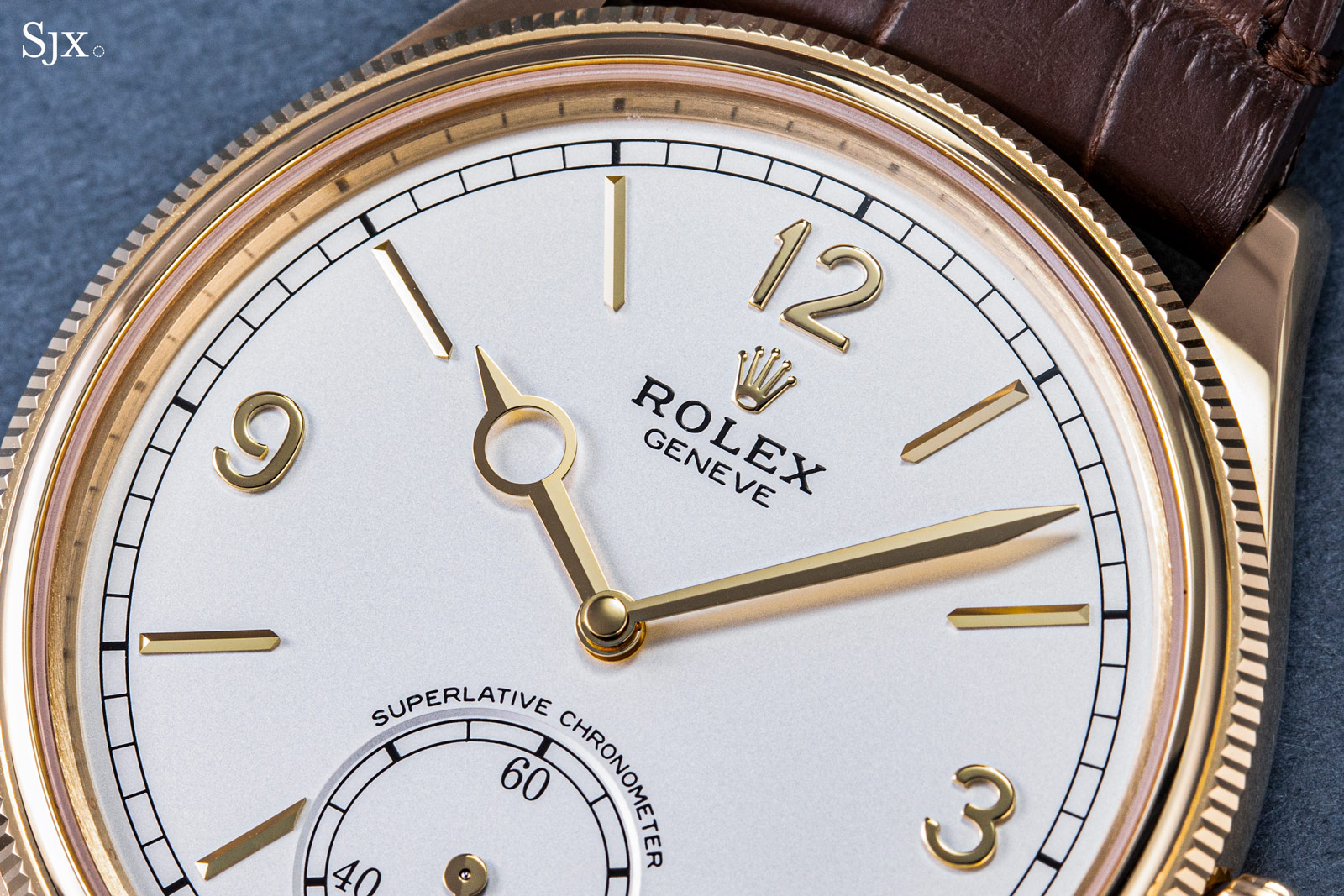
Rolex has maintained a leading position in the Swiss watch industry for decades arguably thanks to its ability to anticipate major shifts in consumer preferences. The brand helped catalyse the shift from pocket- to wristwatches, then kept the faith in mechanical movements during the Quartz Crisis, and invested heavily in vertical integration just as mechanical watches took off as a luxury good – everything the brand did set itself up for the success it now enjoys.
While the past few years have been all about steel sports watches, at least in terms of public recognition, Rolex has been around long enough to know that nothing lasts forever. The thoughtful details and outstanding execution of the Perpetual 1908 show the brand can continue to be a dominant player even if tastes shift to favour dress watches.
Satisfyingly luxe
In the hand and on the wrist, the 1908 has a pleasing heft that exudes quality. In fact, I’d rate it better in terms of tactile feel than an equivalent gold watch from, say, Jaeger-LeCoultre.
Best described as an elegant take on the Oyster, the case is slim yet curvaceous. It has the familiar Oyster design, but compressed into a thinner form. So it retains the fluted bezel on the front and fluted case back, trademark features of the Oyster case that allow both parts to be screwed into the case middle, which is now surprisingly thin. Impressively, the 1908 is automatic but 0.6 mm slimmer than the manual-wind Omega De Ville Trésor Small Seconds.
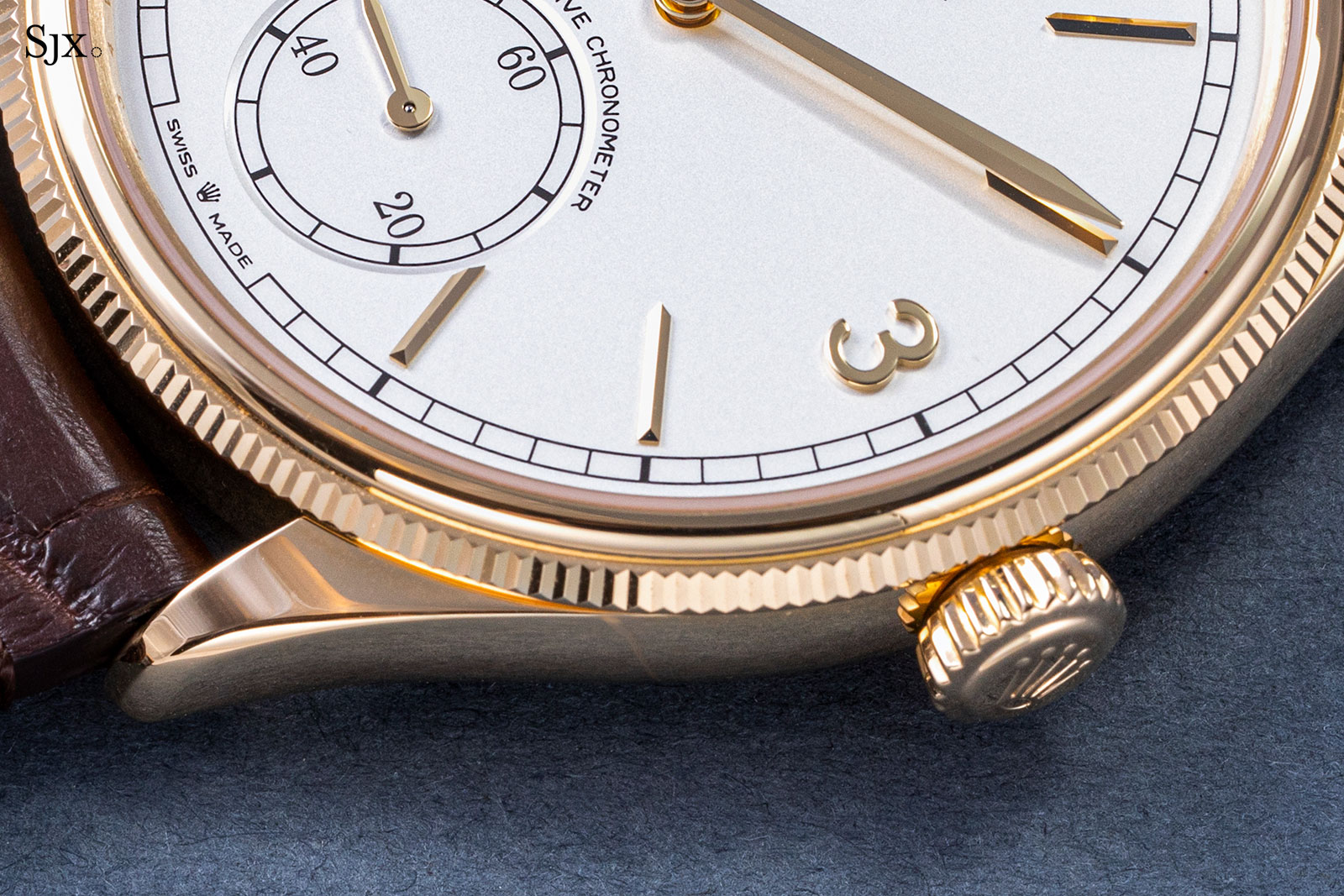

Available in both white and black, the lacquer dial has a satisfying amount of depth when examined up close. That’s thanks to the recessed small seconds and applied, facetted markers and hands, which are naturally 18k gold. While the indices are of substance and quality, they could be fancier, for instance with sharper edges.
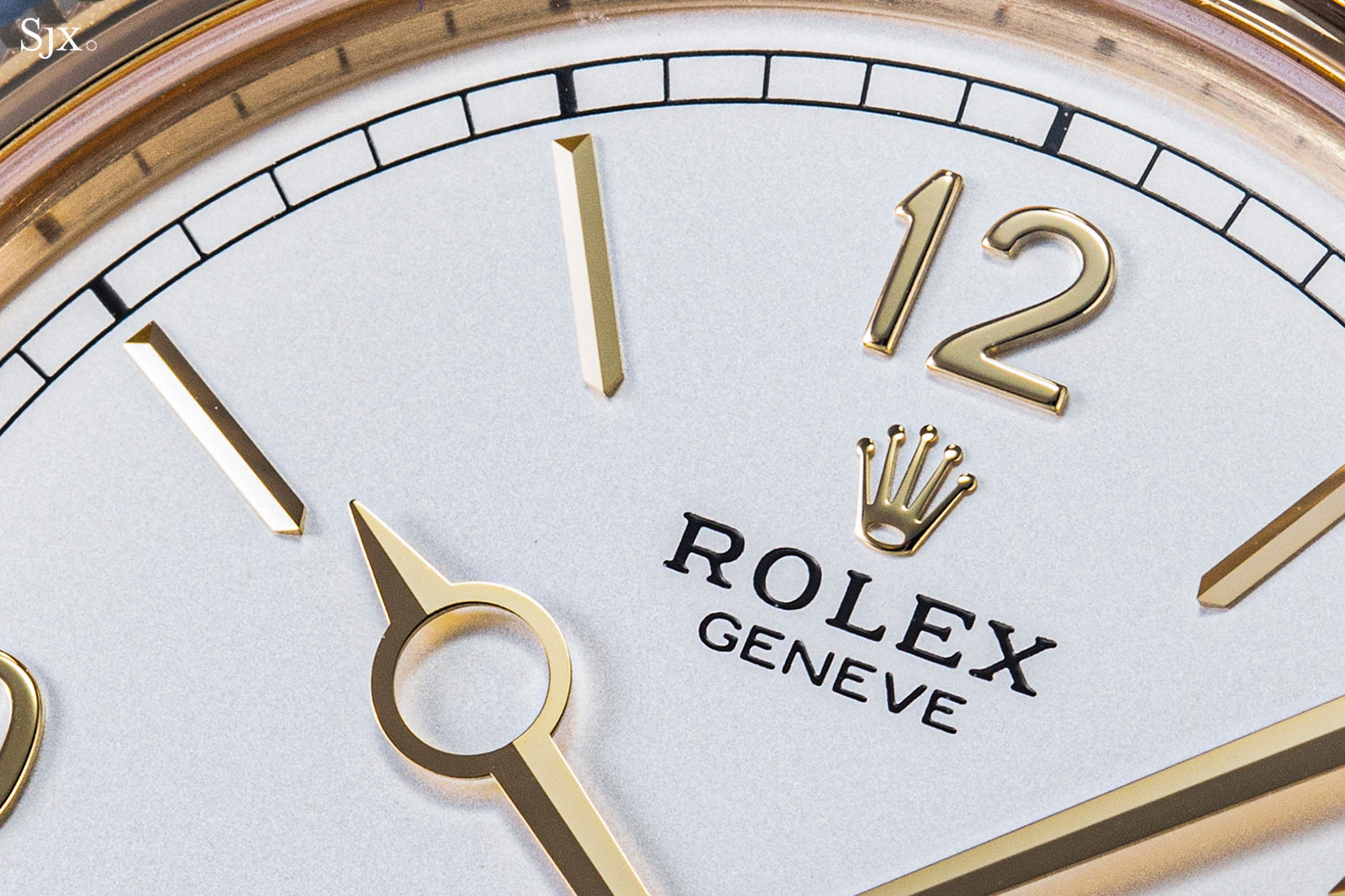
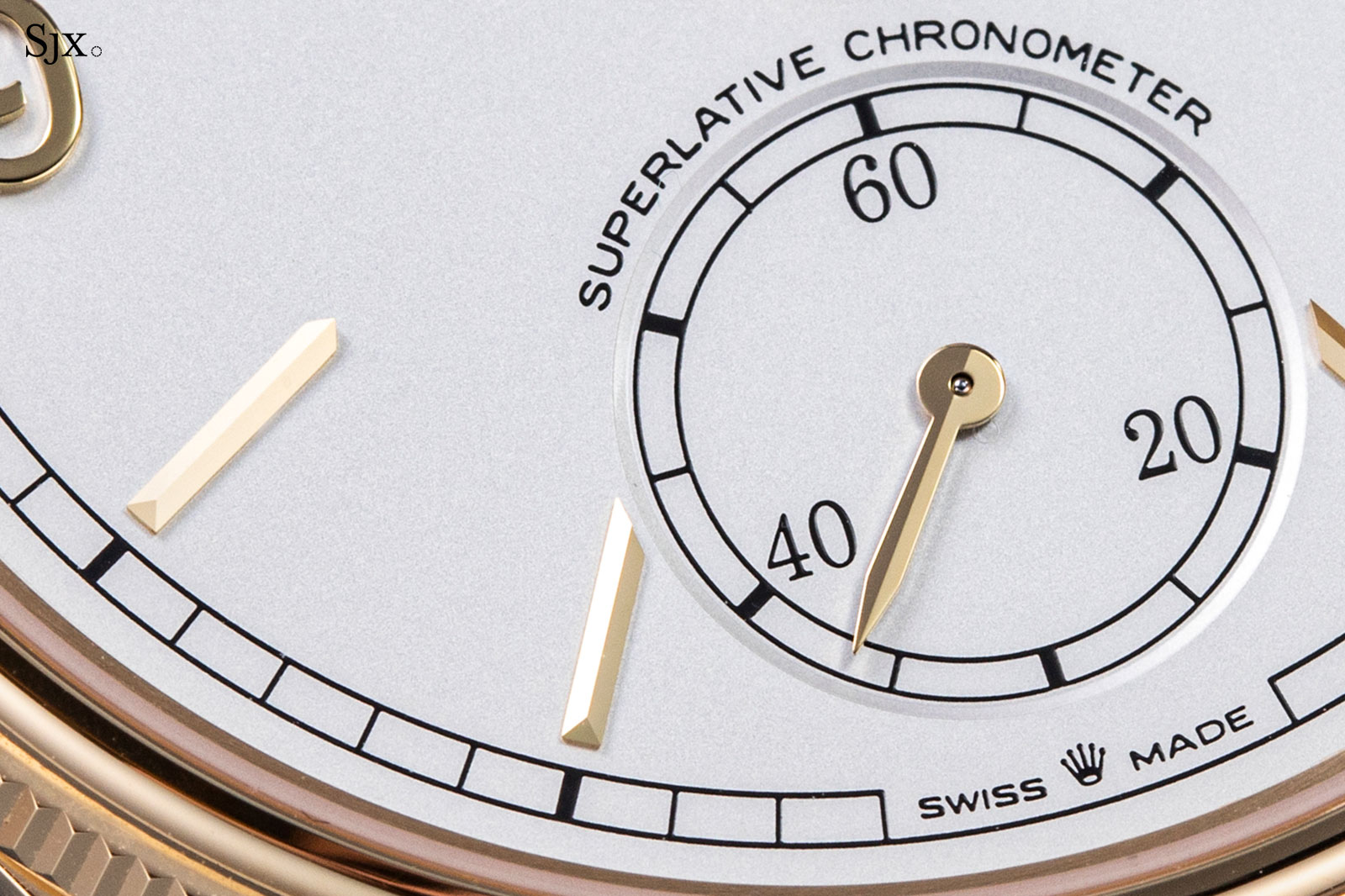
The design is balanced, but conservative and clearly retro inspired. “Superlative Chronometer” over the seconds register, for instance, calls to mind the Rolex Veriflat of the 1950s. Both dial colours work well with the design, but the yellow gold case is the most appealing. Rolex describes the black dial as “intense black” but at some angles the dial appears dark grey, perhaps because of its matte finish. I would have preferred a glossy, piano-like finish that evokes “gilt” dials of vintage watches.
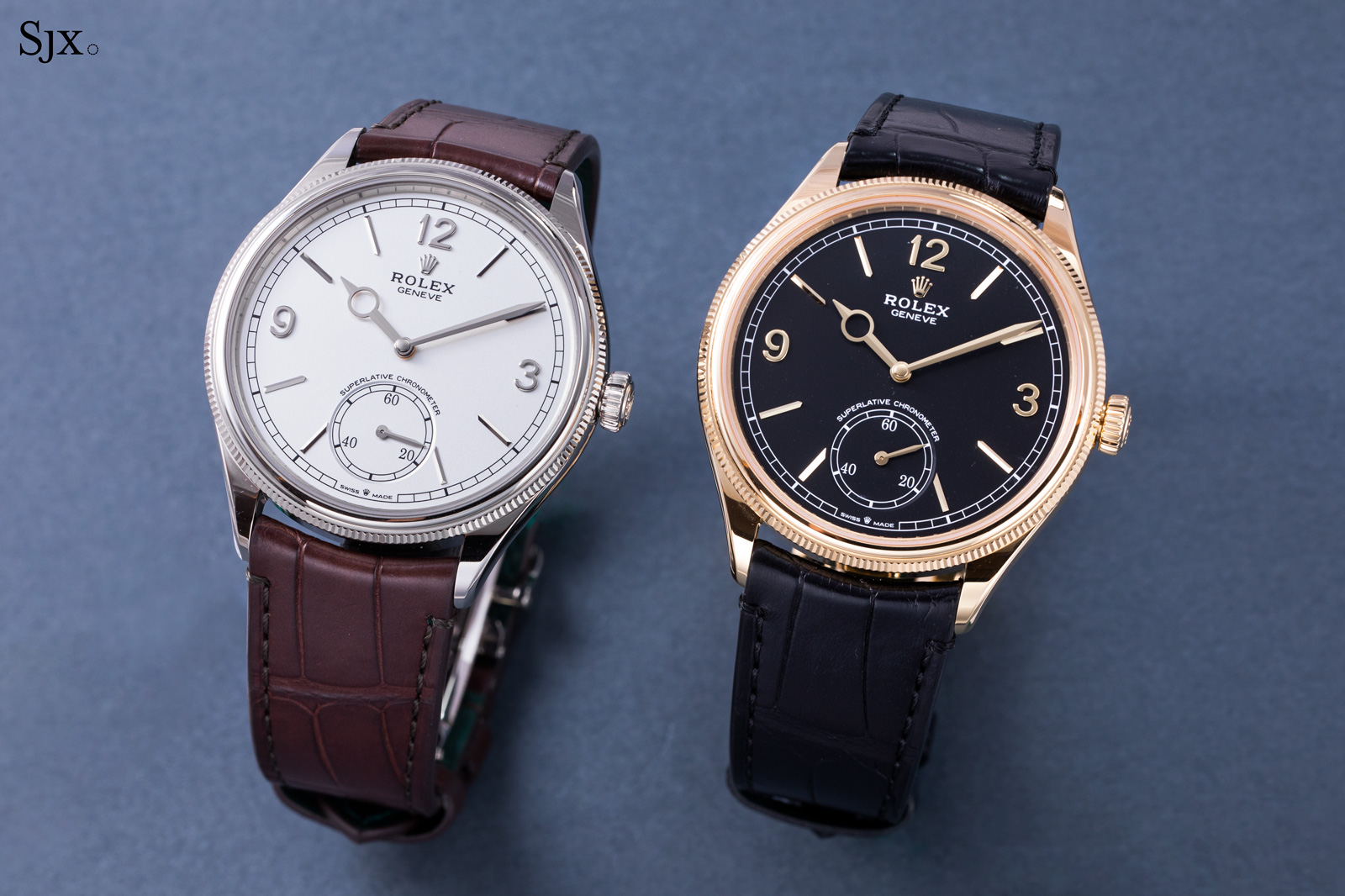
Unusually for Rolex, the 1908 has a small seconds display at six o’clock. Rolex has long favoured the centre seconds – the last time it launched an all-new movement with a sub-seconds was decades ago. As a result, all of the brand’s recent movements have the fourth wheel in the centre of the calibre to directly drive a central seconds hand.
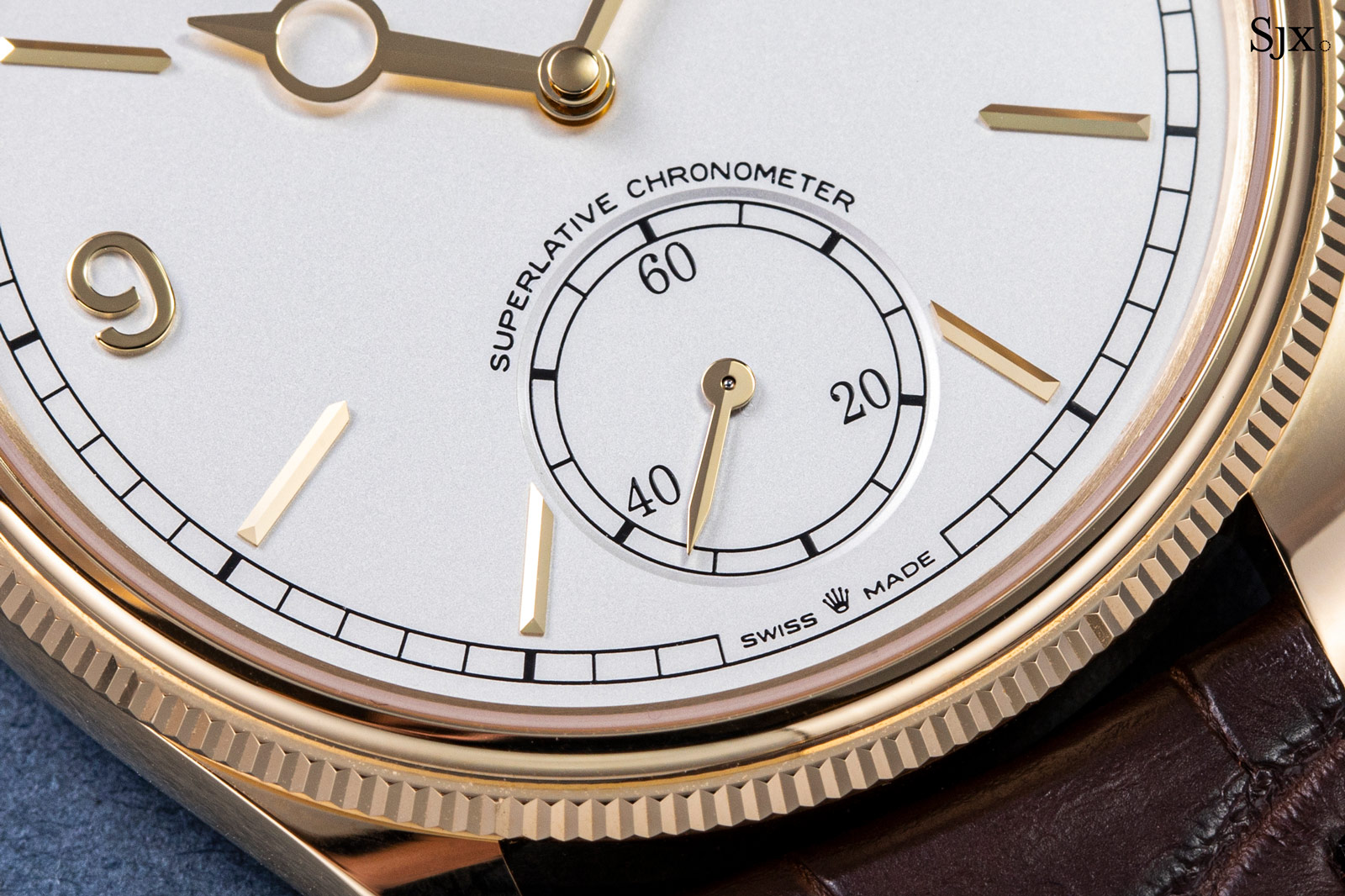
The cal. 7140 in the 1908 is no exception. It still has a fourth wheel in the centre, but relies on an auxiliary gear train to indirectly drive the small seconds. As a result of this construction, the dial has an odd quirk in the form of domed gold cap mounted on the axis of the minute hand. Since it rotates, it functions as a seconds indicator. Though its rotation is somewhat moot given the polished surface (which leaves the rotation almost invisible to the naked eye) it does mean that the cal. 7140 can be easily converted into a centre seconds configuration without substantial technical modifications.
In typical Rolex style, every detail of the 1908 has been attended to. The clasp, for instance, was developed specifically for the watch. It is the brand’s first-ever double-fold clasp, which improves wearability by helping the watch stay centred on the wrist. Notably, the strap is also upgraded over Rolex’s current offerings. While at first glance it looks like any a standard alligator strap, the lining is the brand’s trademark green; a pleasing but subtle detail.
Showtime for Syloxi
At just 4.05 mm in height, the cal. 7140 is 34% thinner than Rolex’s workhorse cal. 3235 found in most of its men’s watches. This is an impressive reduction given the movement retains the capacity to directly drive a centre seconds hand. In fact, the cal. 7140 is 13% thinner than the JLC cal. 899 that was long a favourite base calibre for brands like Audemars Piguet and Vacheron Constantin due to its slim design (though these brands have mostly developed in-house replacements for the cal. 899).
Some of the height savings of the cal. 7140 are due to the flat silicon hairspring known as Syloxi. Rolex introduced Syloxi in 2014, but the technology has rolled out on a limited basis, mostly for small movements in precious metal ladies’ watches. Thanks primarily to its flat form, the Syloxi hairspring takes up 20% less volume than Parachrom “blue”, the brand’s overcoil hairspring made of magnetism-resistant alloy.
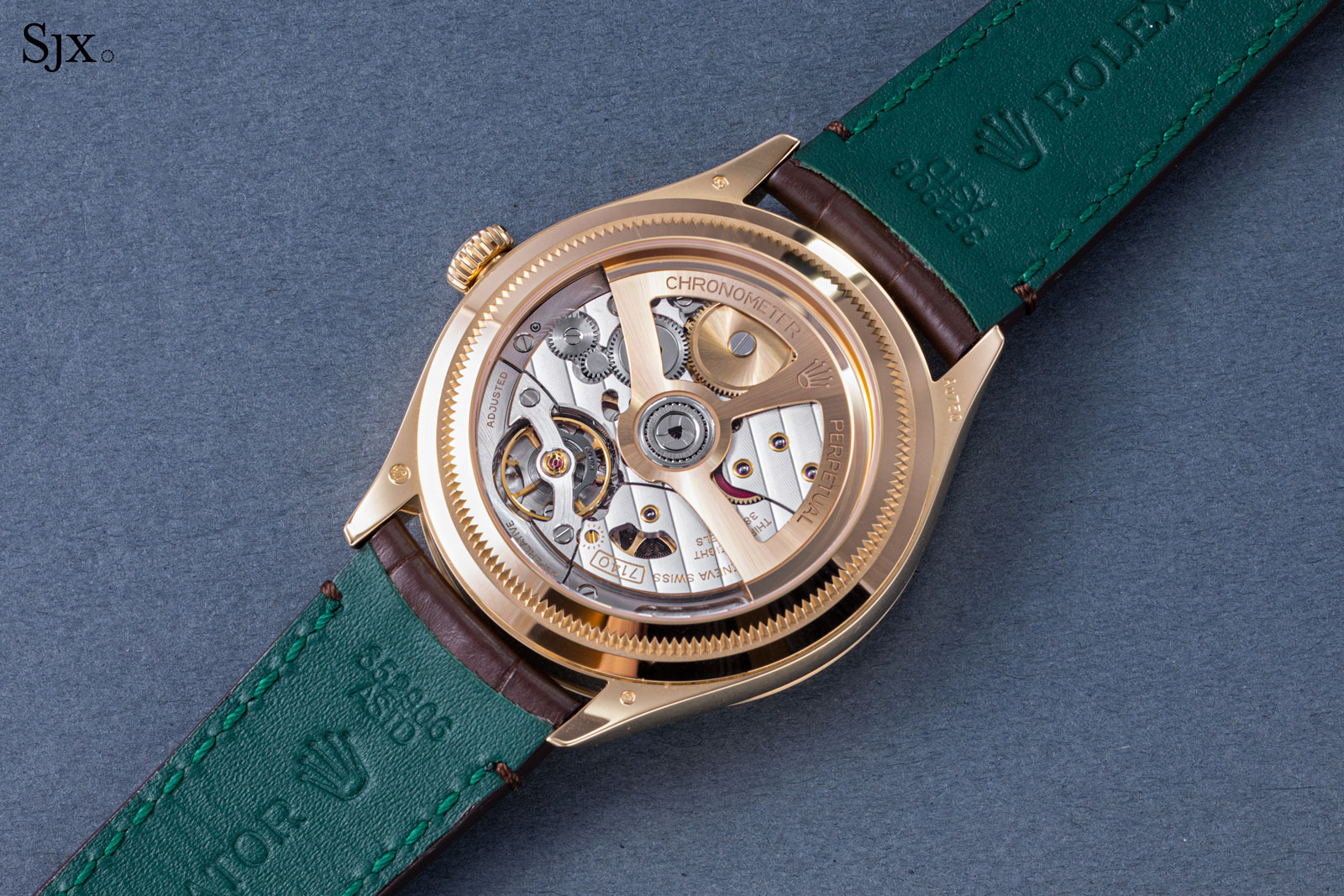
Historically an overcoil hairspring was preferable to a flat hairspring because it breathes more concentrically, improving isochronism. But that was true only for traditional hairsprings made of metal alloys like Nivarox, which have to be coiled from lengths of wire. One of the benefits of silicon is that it can be engineered to possess the geometry of a flat spring but the concentric breathing of an overcoil spring.
As a result, the cal. 7140 is tested to the same standards of precision as Rolex’s overcoil-equipped watches. Specifically, every cal. 7140 is chronometer-certified by COSC before being cased. Then each finished watch is tested again by Rolex to ensure that they meet the brand’s own Superlative Chronometer standard of +/- 2 seconds per day.
Superlative Chronometer was the most exacting certification in the industry, until the recent launch of the Spirate-equipped Omega Speedmaster Super Racing that is tested to 0/+2 seconds per day. That said, the new Omega testing standard is limited to just that Speedmaster for now, while Rolex in contrast tests all its million-or-so watches to the Superlative Chronometer standard.
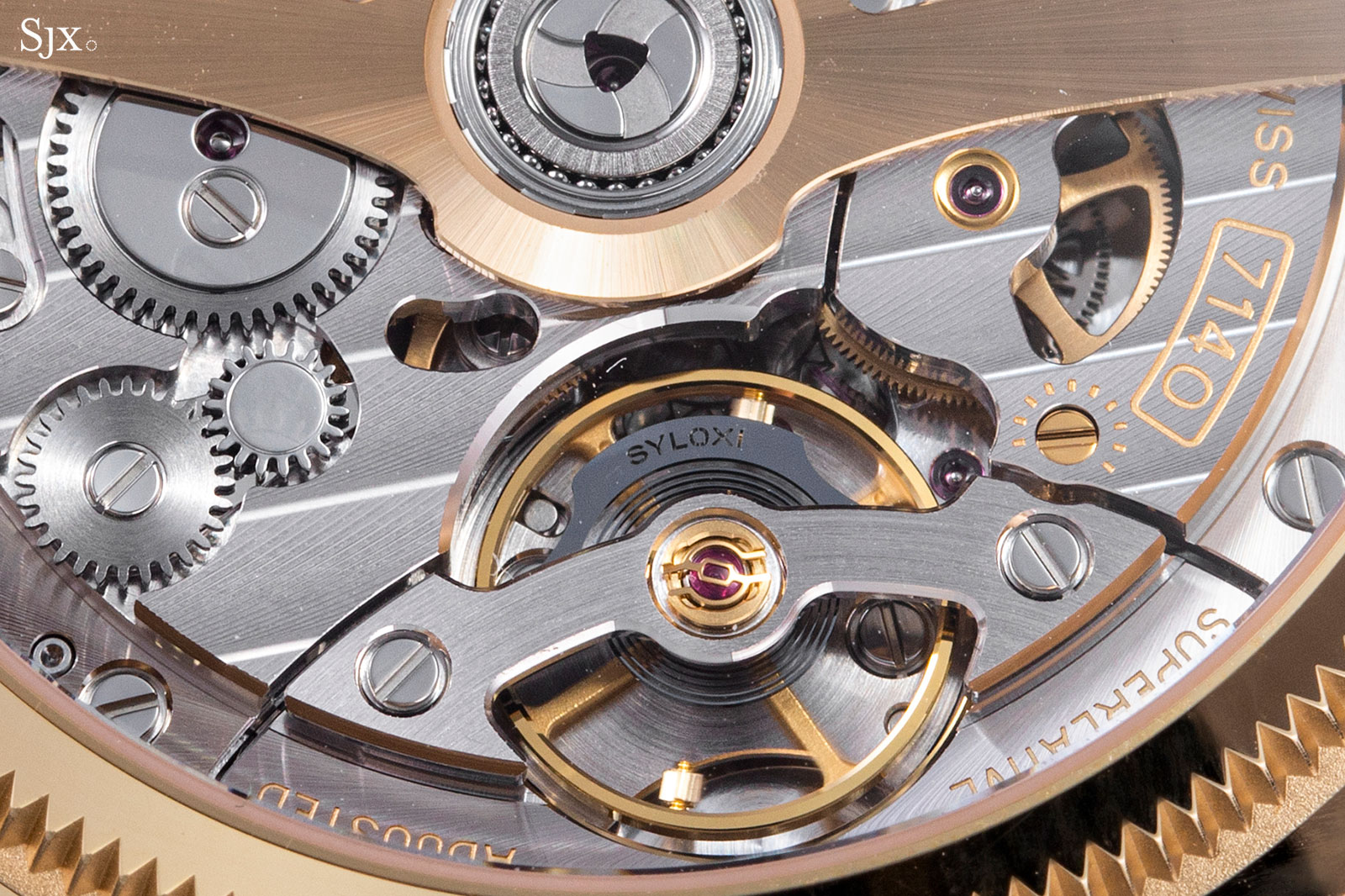
Interestingly, Rolex is still introducing new movements with metal hairsprings in parallel with the more widespread use of Syloxi. In fact, majority of Rolex watches, including the latest launches still feature a Parachrom hairspring. Thicker movements like the new cal. 4131 in the latest-generation Daytona still get overcoil hairsprings, and only the smaller, thinner movements like the cal. 7140 get a Syloxi spring.
Reading between the lines, the brand appears to favour metallic overcoil hairsprings when space permits. An inference might be that all things being equal, a metallic hairspring is superior – except when there is a space constraint.
But the performance of a movement is not all about the hairspring; the cal. 7140 also features the Chronergy escapement. A good part of the outstanding performance of Rolex movements can be attributed to this escapement, which is 15% more efficient than a standard lever escapement. New escapement designs are notoriously difficult to commercialise and the Chronergy escapement was confined to the cal. 32xx movement family after its 2015 launch. But since then it has been incorporated into other movement families, meaning Rolex must be satisfied with Chronergy’s performance and serviceability.
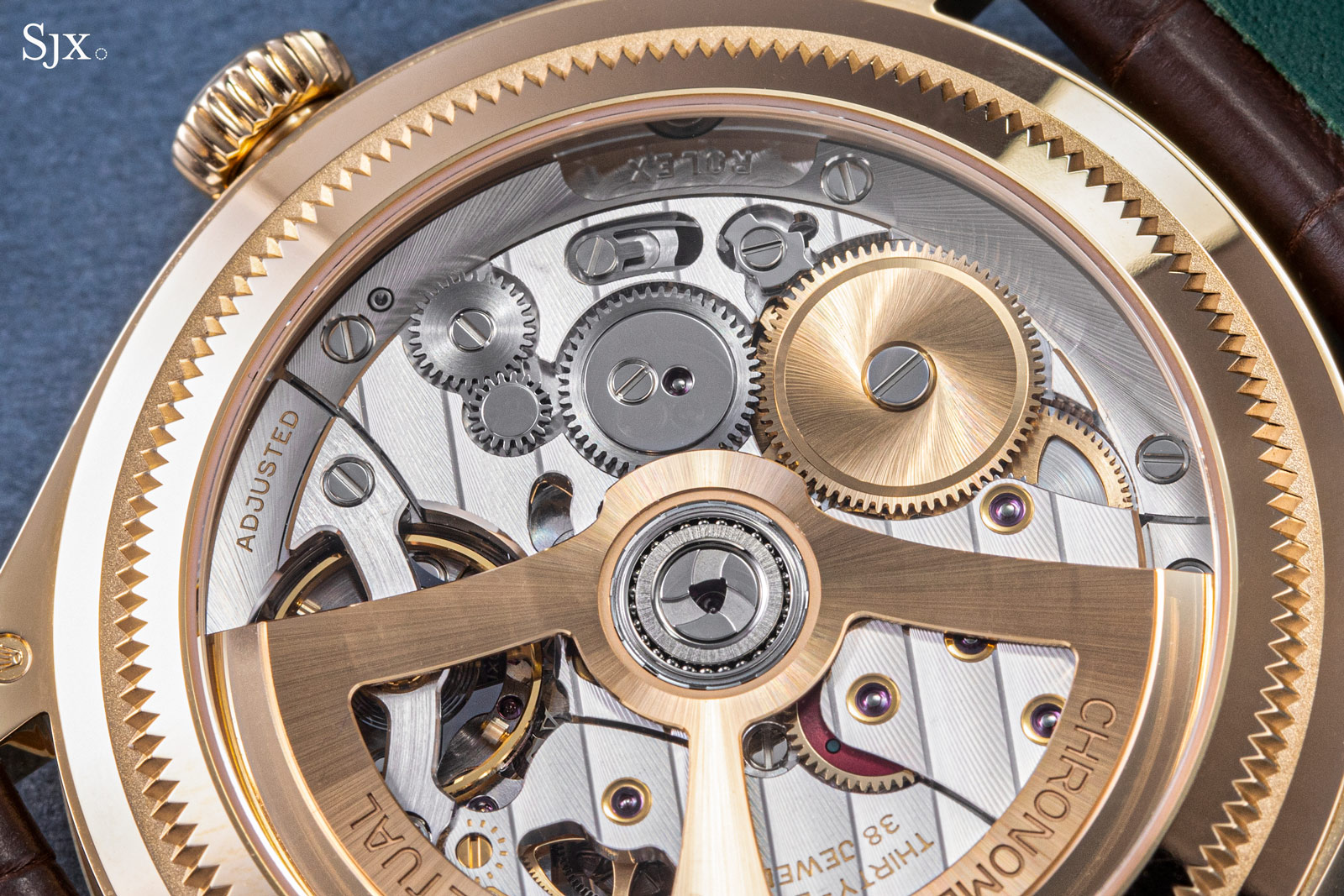
Fresh finishing
The cal. 7140 also debuts a new style of movement finishing for Rolex. With its traditional striping and 18k gold oscillating weight, it could be mistaken at first glance for a traditional, high-end automatic like the Jaeger-LeCoultre cal. 899 or Parmigiani cal. PF441. But a closer look reveals the trademark Teflon-coated winding wheel and Paraflex shock absorber that are unique to Rolex.
Having grown accustomed to the clean, no-fuss finishing employed by Rolex over the past two decades, the new look is almost shocking – in a good way. Neat and precise, the decoration looks good. The components gleam, from the screw heads to the sunray-brushed gold rotor to the solarised ratchet wheel. Even the engraving is notable for its clean edges and attractive typeface; this is an example of the seemingly trivial details that many brands tend to overlook but are executed well here.
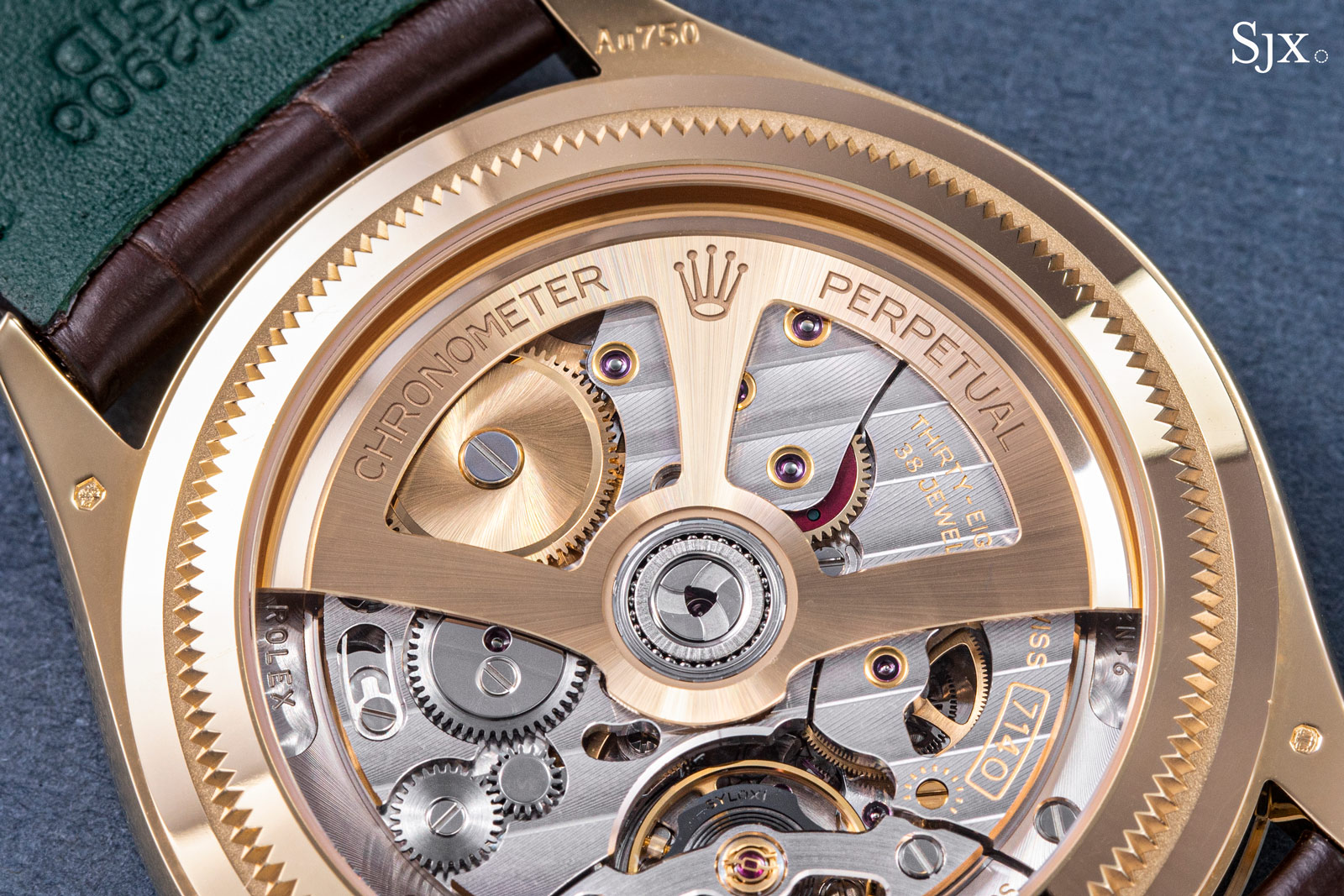
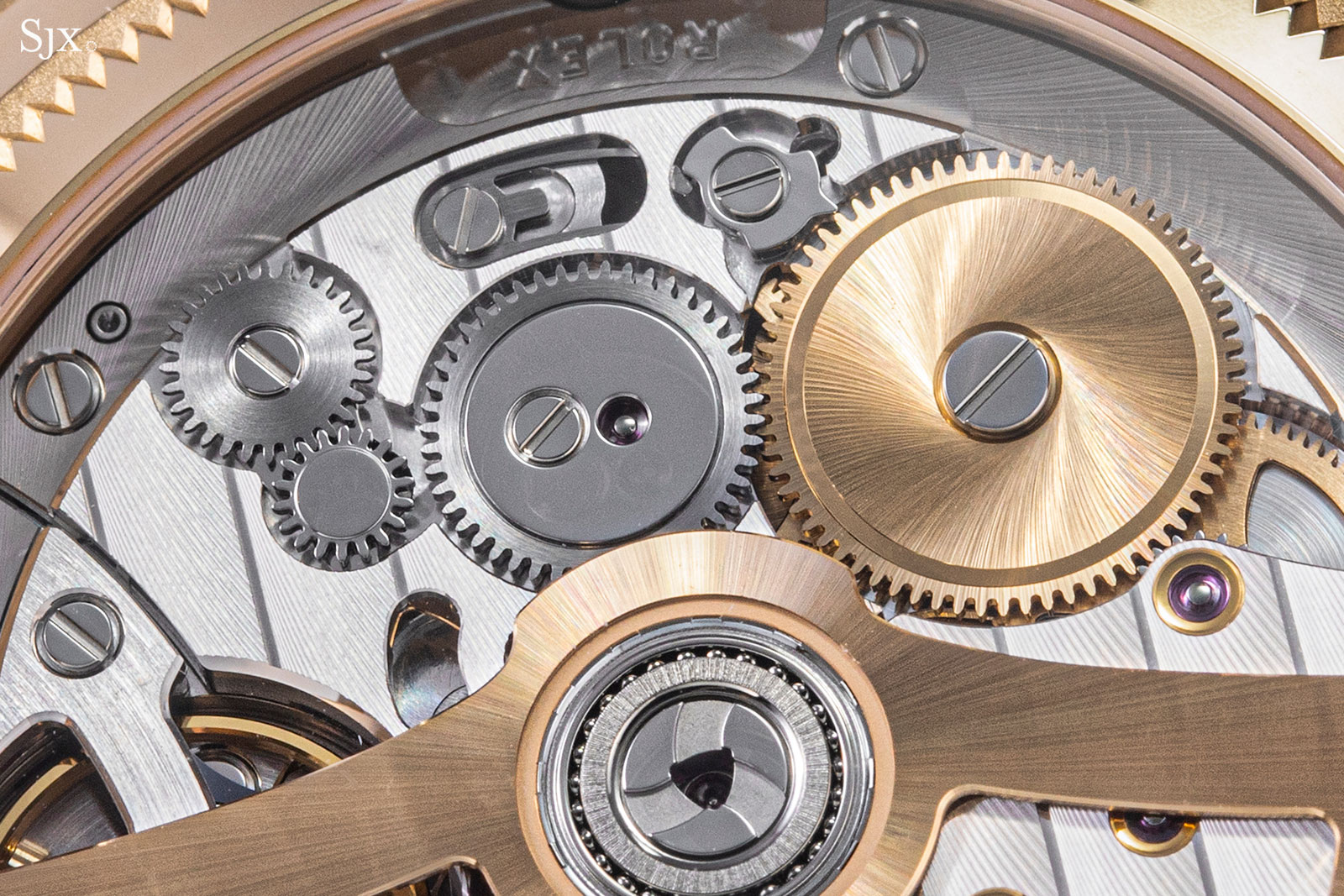
That said, there are naturally a few telltale signs that the movement is an industrial product, most obviously in the perfect edges and surfaces. The machine-applied anglage is also impressively smooth and catches the light nicely, though it’s been applied strategically to only the most obvious surfaces; only the balance bridge and nearest edge of the barrel bridge are chamfered.
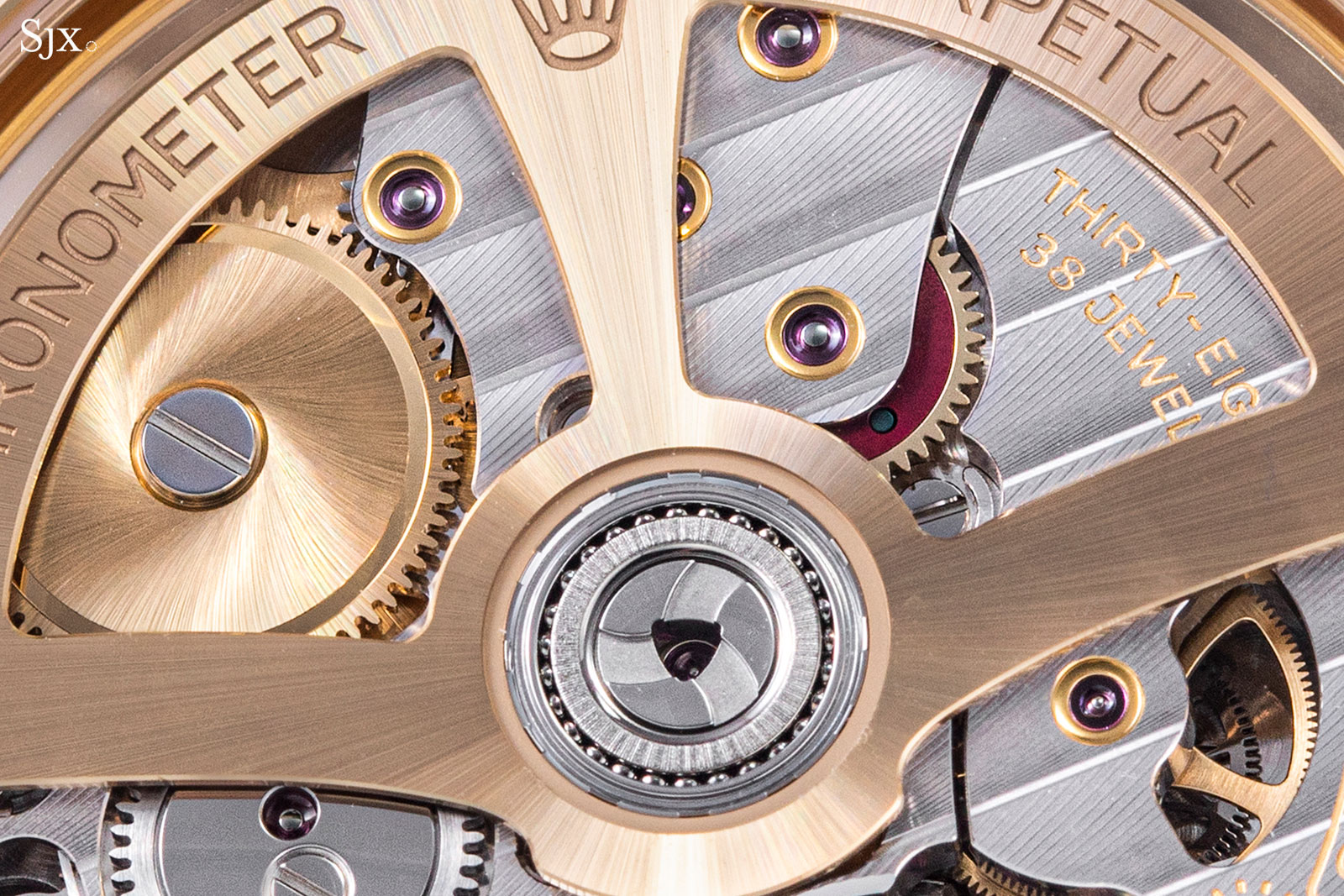
The bridges are finished with Rolex’s own take on Côtes de Genève, a style that includes a narrow, polished groove between each stripe. The striping covers the barrel and gear train bridges, however, it does not extend to the balance bridge, which features the same linear-grained finish found in other Rolex movements like the cal. 3235.
I can guess why this was done. For one, the arch of the balance bridge echoes the direction of the striping. More practically, the balance bridge is too narrow for striping along its length. But I would have still preferred to solve this by simply changing the direction of the stripes, as is practiced by Audemars Piguet. As it is, the finishing seems incomplete.
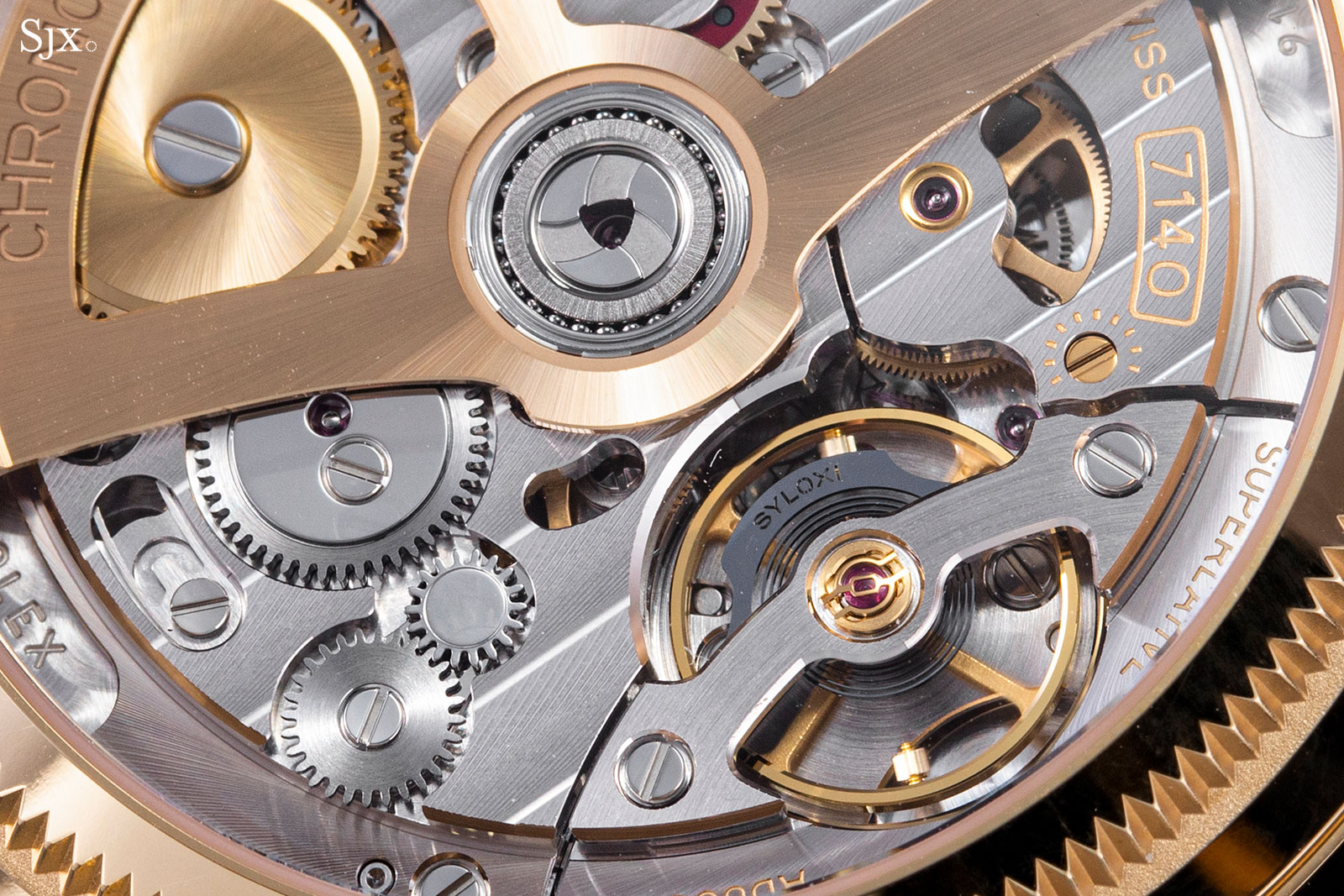
Another interesting detail is what appear to be gold chatons around some of the jewels. Chatons have been obsolete for decades, but some haute horlogerie brands, especially German brands, use them as an anachronistic showcase of craftsmanship since they are fitted by hand. In the cal. 7140, the chatons are in fact borders machined into the bridges that are then gold plated.
Because they are not actual rings fitted into the bridges, the faux chatons might be seen as a concession to economy. But the machining of the gold rings into the bridges is so impressively fine that I imagine most brands would find it cheaper use actual chatons since fitting chatons is an easy, albeit manual task. But because Rolex boasts peerless manufacturing prowess, machining faux chatons is a better option, both in terms of long-term serviceability and cost.
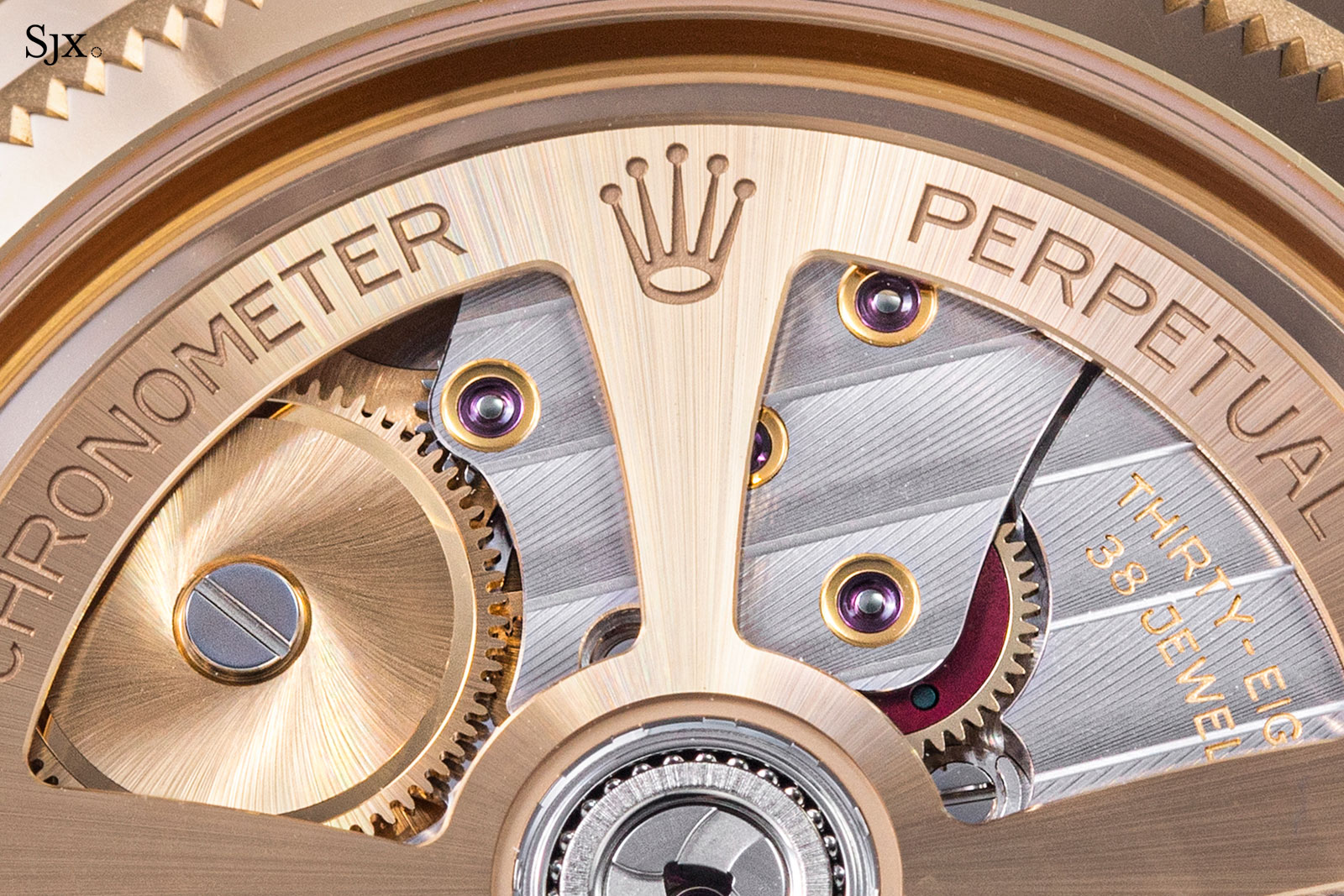
Concluding thoughts
Because of the obvious quality of make, the 1908 has tangible appeal. Unusually robust for a dress watch, it feels good in the hand. If I had to bet on a dress watch that would still be water resistant a century later, it would be the 1908. Importantly, the movement looks better than I would have expected for the brand’s first foray into fine finishing and clearly demonstrates Rolex’s mastery of industrial watchmaking.
More broadly, the 1908 is an important watch. Before W&W, if you’d have told me that a dress watch would overshadow the launch of the new-generation Daytona, I’d have been sceptical. But I liked the 1908 when I first saw the images, and my impression has only improved since handling the watch and seeing how it fits into the Rolex strategy. Whether you like the watch or not, there’s no denying its significance.
The 1908 might be a clever strategic move in the long term (which is the only time scale that Rolex considers). For the past few years, the brand has been under pressure to ramp up production of a bestseller, often steel sports watches, to meet unprecedented demand. It has responded by announcing plans to increase production – over a long time horizon – but it is clearly trying another method of alleviating this issue, offering a compelling alternative. If the 1908 is successful – and the Perpetual collection grows in diversity – it should help balance demand across Rolex’s portfolio and improve margins. It will probably take some gentle facelifts and time to get there, but the Perpetual collection will evolve into an important pillar of the Rolex catalogue.
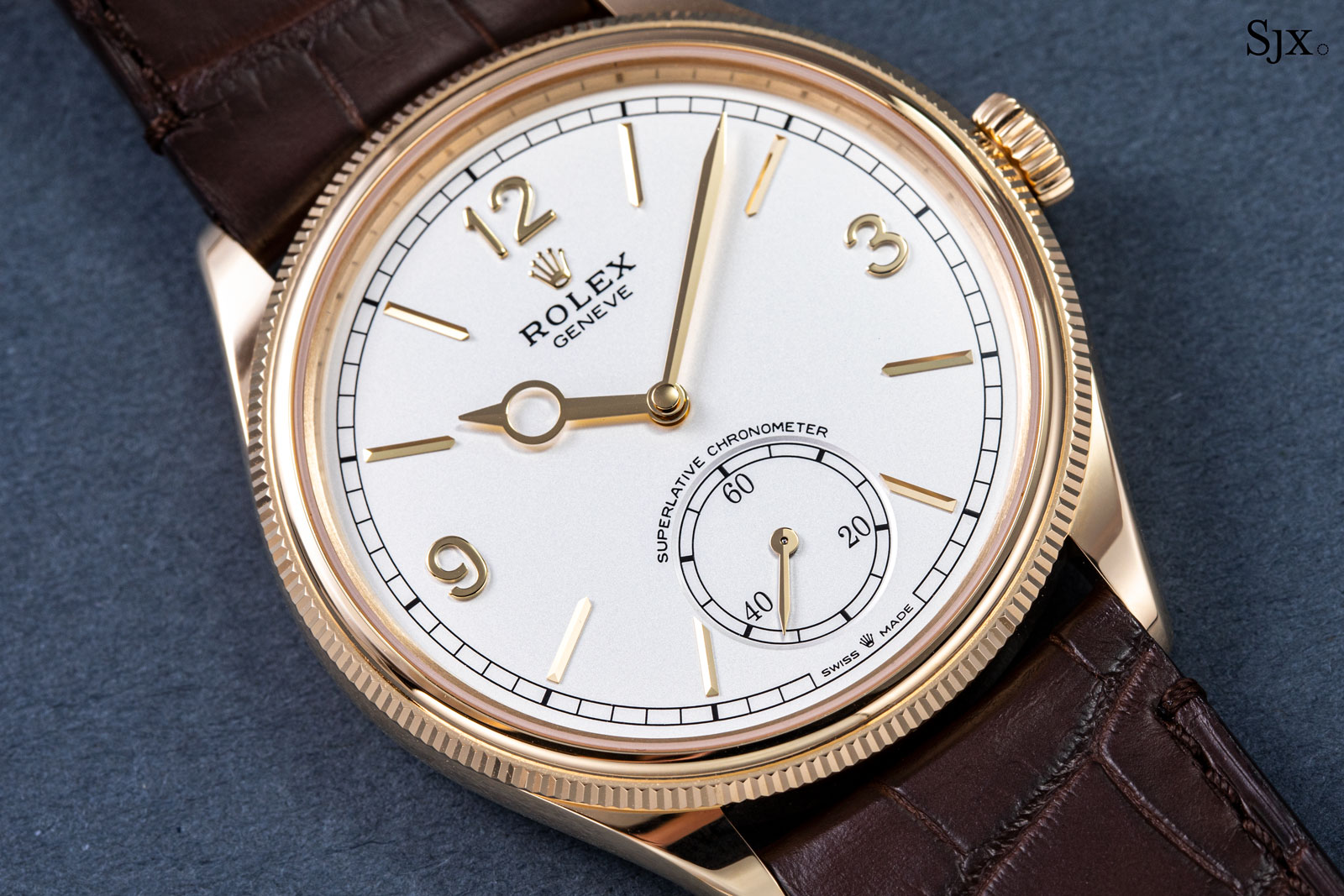
Key facts and price
Rolex Perpetual 1908
Ref. 52508 (YG)
Ref. 52509 (WG)
Diameter: 39 mm
Height: 9.5 mm
Material: 18k white gold or yellow gold
Crystal: Sapphire
Water resistance: 50 m
Movement: Cal. 7140
Features: Hours, minutes, sub-seconds
Frequency: 28,800 beats per hour (4 Hz)
Winding: Automatic
Power reserve: 66 hours
Strap: Alligator with folding clasp
Limited edition: No
Availability: Available at Rolex authorised dealers
Price: US$22,000 (YG); US$23,300 (WG)
Prices exclude local taxes
For more, visit rolex.com.
Back to top.

